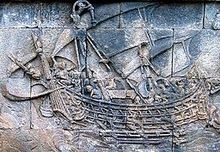Tanja sail: Difference between revisions
remove copyright content copied from http://www.forumms.com/traditional_boats.htm |
Verosaurus (talk | contribs) Reference to be added |
||
| Line 10: | Line 10: | ||
The 3rd century book "''Strange Things of the South''" (南州異物志) by Wan Chen (萬震) describes large ships which originates from ''K'un-lun'' (Southern country, either [[Java]] or [[Sumatra]]). The ships called ''[[Djong (ship)|K'un-lun po]]'' (or ''K'un-lun bo''). He explains the ship's sail design as follows:{{quote|The four sails do not face directly forward, but are set obliquely, and so arranged that they can all be fixed in the same direction, to receive the wind and to spill it. Those sails which are behind the most windward one receiving the pressure of the wind, throw it from one to the other, so that they all profit from its force. If it is violent, (the sailors) diminish or augment the surface of the sails according to the conditions. This oblique rig, which permits the sails to receive from one another the breath of the wind, obviates the anxiety attendant upon having high masts. Thus these ships sail without avoiding strong winds and dashing waves, by the aid of which they can make great speed.|Wan Chen|<ref>"''Strange Things of the South''", Wan Chen, from Robert Temple</ref>}} |
The 3rd century book "''Strange Things of the South''" (南州異物志) by Wan Chen (萬震) describes large ships which originates from ''K'un-lun'' (Southern country, either [[Java]] or [[Sumatra]]). The ships called ''[[Djong (ship)|K'un-lun po]]'' (or ''K'un-lun bo''). He explains the ship's sail design as follows:{{quote|The four sails do not face directly forward, but are set obliquely, and so arranged that they can all be fixed in the same direction, to receive the wind and to spill it. Those sails which are behind the most windward one receiving the pressure of the wind, throw it from one to the other, so that they all profit from its force. If it is violent, (the sailors) diminish or augment the surface of the sails according to the conditions. This oblique rig, which permits the sails to receive from one another the breath of the wind, obviates the anxiety attendant upon having high masts. Thus these ships sail without avoiding strong winds and dashing waves, by the aid of which they can make great speed.|Wan Chen|<ref>"''Strange Things of the South''", Wan Chen, from Robert Temple</ref>}} |
||
== Usage == |
|||
[[File:Borobudur ship.JPG|thumb|[[Borobudur ship]] carving]] |
[[File:Borobudur ship.JPG|thumb|[[Borobudur ship]] carving]] |
||
Most Malayo-Ausronesian vessel uses the tanja sail. This type of sail brought Malay sailor as far as [[Ghana]], and there is probability these sailor reached the New World as early as 1420 A.D. using Javanese junks. These are vessels that use tanja sail: |
|||
* [[Borobudur ship]] |
|||
* [[Javanese junk#History|K'un-lun po]] |
|||
* [[Lancaran (ship)|Lancaran]] |
|||
* Padewakang |
|||
* [[Garay|Pangajava]] |
|||
* [[Lanong]] |
|||
* [[Karakoa]] |
|||
* [[Kakap (boat)|Kakap]] |
|||
* [[Djong (ship)|Djong]] |
|||
* [[Perahu]]<br /> |
|||
== See also == |
== See also == |
||
* [[Lug sail]] |
* [[Lug sail]] |
||
Revision as of 13:06, 23 June 2018
Tanja sail or tanja rig is a type of sail commonly used by the Malay and Austronesian people, particularly in the Indonesian, Malaysian, and Philippine archipelago.
Origins
Also called tanjaq, tanjak, or tanja' sail. The Mandar people call it sombal tanjaq. It is called so because when the wind blows the lower part of the sail (peloang) would "mattanjaq" (lit. "kicking").[1]
Characteristics
Tanja sail can be distingushed by its canted/oblique design. The sail face is assymetrical in shape and most of the area is elongated to the sides, rather than upward like those of lug sail.
The 3rd century book "Strange Things of the South" (南州異物志) by Wan Chen (萬震) describes large ships which originates from K'un-lun (Southern country, either Java or Sumatra). The ships called K'un-lun po (or K'un-lun bo). He explains the ship's sail design as follows:
The four sails do not face directly forward, but are set obliquely, and so arranged that they can all be fixed in the same direction, to receive the wind and to spill it. Those sails which are behind the most windward one receiving the pressure of the wind, throw it from one to the other, so that they all profit from its force. If it is violent, (the sailors) diminish or augment the surface of the sails according to the conditions. This oblique rig, which permits the sails to receive from one another the breath of the wind, obviates the anxiety attendant upon having high masts. Thus these ships sail without avoiding strong winds and dashing waves, by the aid of which they can make great speed.
— Wan Chen, [2]
Usage

Most Malayo-Ausronesian vessel uses the tanja sail. This type of sail brought Malay sailor as far as Ghana, and there is probability these sailor reached the New World as early as 1420 A.D. using Javanese junks. These are vessels that use tanja sail:
- Borobudur ship
- K'un-lun po
- Lancaran
- Padewakang
- Pangajava
- Lanong
- Karakoa
- Kakap
- Djong
- Perahu
See also
References
- ^ Haryadi, Rohmat (13 November 2017). "Padewakang the Spice Ship of Nusantara". Gatra. Retrieved 20 June 2018.
{{cite web}}: Cite has empty unknown parameter:|dead-url=(help) - ^ "Strange Things of the South", Wan Chen, from Robert Temple
